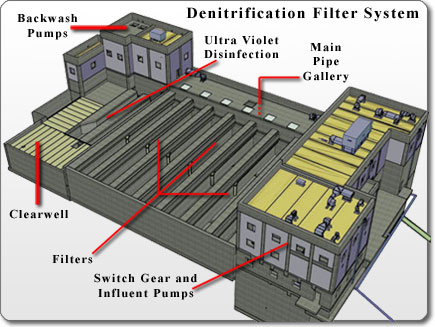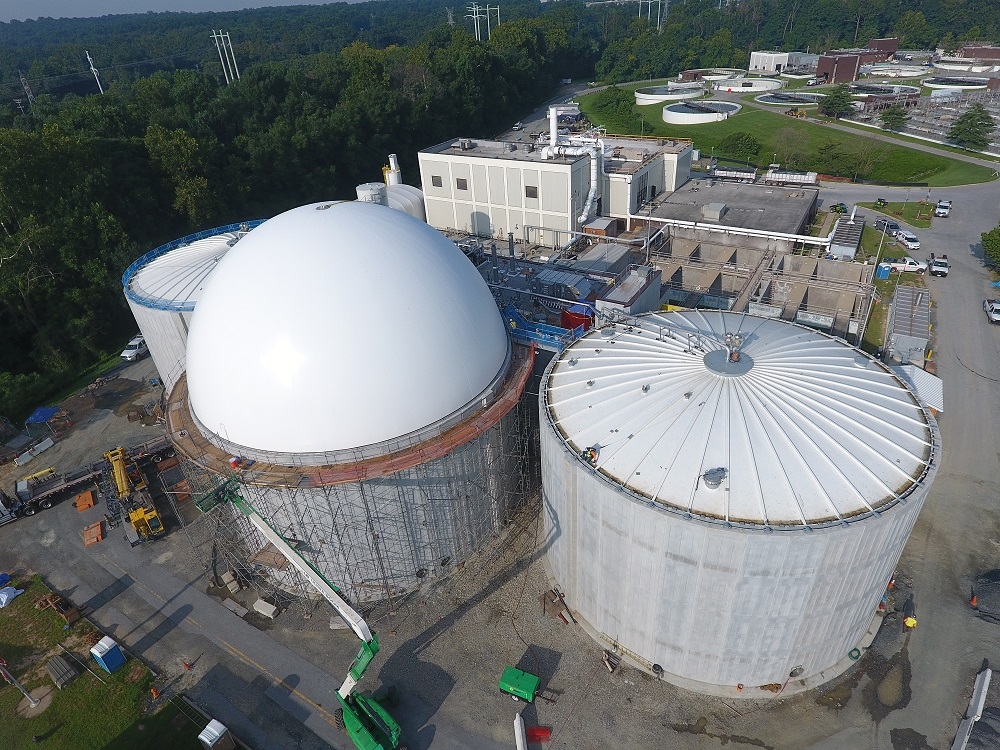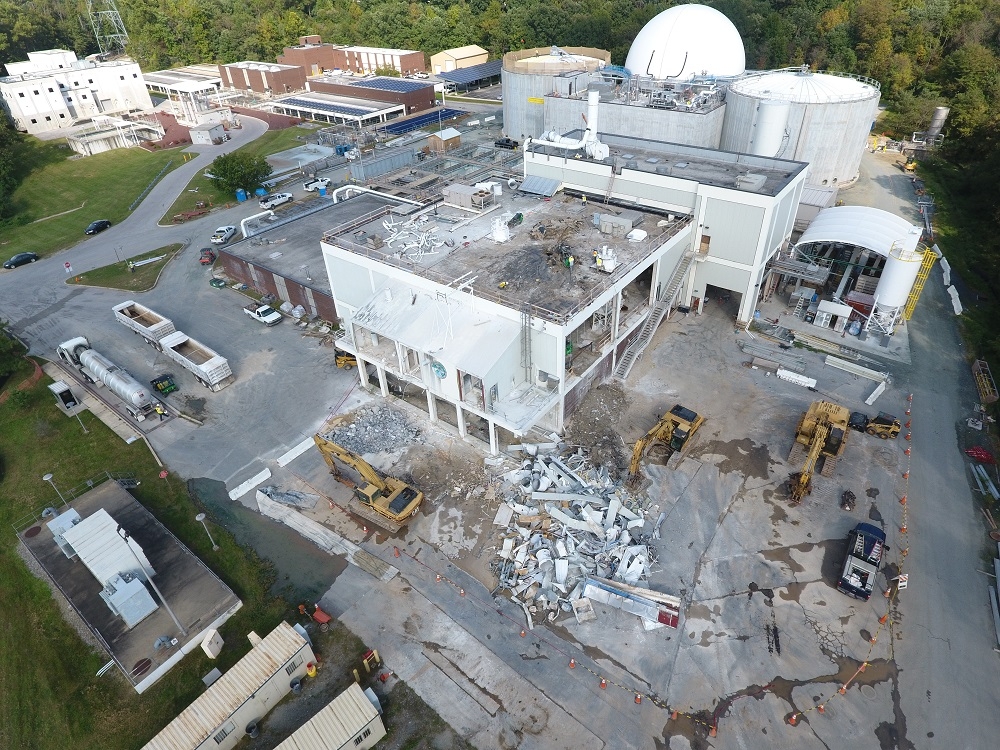LPWRP - Enhanced Nutrient Removal
The Little Patuxent Water Reclamation Plant is undergoing a $92-million Enhanced Nutrient Removal Expansion and Improvements project (Addition No. 7).
Completion of the ENR portion of the project is scheduled to be placed in service in spring of 2012. This will increase the plant's ability to treat wastewater before its release into the Little Patuxent River and eventually, the Chesapeake Bay.
Excess nutrients, like nitrogen and phosphorus, lead to degraded water quality, which negatively impacts plant and animal life in the Chesapeake Bay and its tributaries. These excess nutrients can flow into the Bay from wastewater treatment plant discharges, stormwater runoff and from rainfall.
Howard County is excited to be moving forward with this advanced treatment technique to facilitate the cleanup efforts.
Enhanced Nutrient Removal is the use of technologies that will allow wastewater treatment plants to provide an advanced level of treatment. The goal of ENR is to achieve effluent nutrient concentrations of a maximum of 3.0 milligrams per liter (mg/l) total nitrogen and 0.3 mg/l total phosphorus.
The technology being used at the Little Patuxent Water Reclamation Plant is the installation of denitrification filters. These filters will convert nitrate-nitrogen into nitrogen gas thus reducing the amount of nutrients entering the Bay watershed.
Please use the links below to find out how Howard County is using this process to protect one of our most valuable natural resources.
LPWRP - ENR - Water Treatment Links
For more information on the Enhanced Nutrient Removal process please visit the following links:
(Links will open in a new window)
Maryland Department of the Environment ENR webpage
Informative PDF documents :
Wastewater Treatment Plants ENR Upgrade Status
MDE Wastewater Treatment Plants Reports
Md General Assembly Policy Note on Patuxent River Watershed
MDE's publication "EnviroMatters" focusing on ENR
Thank you for your interest in preserving one of our most valuable natural resources.
History
Prior to 1972, when the Clean Water Act was passed, wastewater treatment plants consisted of Primary Treatment which consists of bar screens, grit removal and primary settling tanks (clarifiers). Primary treatment removes only 45 to 50% of pollutants. Following the Clean Water Act, Maryland began to require Secondary Treatment at large municipal wastewater treatment plants. Secondary Treatment involves the installation of a biological process (activated sludge, trickling filter, etc.) that breaks down the waste further. This process can remove up to 90% of pollutants.
In 1983, the first Chesapeake Bay Agreement was signed by the Environmental Protection Agency (EPA), Maryland, Pennsylvania, Virginia and the District of Columbia. This Agreement set the stage for implementing a program to restore the health of the Chesapeake Bay. The second Chesapeake Bay Agreement was signed in 1987. In addition to other pollution reducing initiatives, the Agreement required a 40% reduction in nutrient contributions to the Bay by 2000. To achieve the 40% reduction, Maryland required the installation of Biological Nutrient Removal (BNR) infrastructure to Maryland’s largest 66 wastewater treatment plants. The goal of BNR is to reduce effluent nitrogen concentrations to less than 8 mg/L and phosphorus concentrations to less than 2 mg/L. It consists of the installation of infrastructure that provides suitable conditions for the growth of specific groups of micro-organisms that can remove nutrients from the wastewater.
Realizing that more needed to be done to improve the health of the Bay; the third Chesapeake Bay Agreement was signed in 2000. This Agreement lays out goals for the restoration of the Chesapeake Bay over the next decade. To achieve these goals, Maryland is requiring the installation of Enhanced Nutrient Removal (ENR) technologies on Maryland’s 66 largest wastewater treatment plants. ENR technologies include denitrification filters and membrane reactors. New ENR facilities will treat wastewater to a maximum monthly nitrogen concentration of 3.0 mg/L nitrogen and 0.3 mg/L phosphorus. The Bay Restoration Fund, established in 2004, will fund the ENR upgrades.
LPWRP - ENR - Funding
What is the Bay Restoration Fund?
Water quality in the Chesapeake Bay has been steadily declining over the past 50 years due to an overload of nutrients, primarily nitrogen and phosphorus.
The four major contributors of nutrients to the Bay are :
- Combustion of fossil fuels ( vehicles, industry and electric utilities )
- Urban runoff
- Agricultural runoff
- Effluent from waste water treatment plants
The Bay Restoration Fund was signed into law on May 26, 2004. The purpose of the Law was to create a Fund, financed by the waste water plant users, to fund ENR upgrades to the State’s largest wastewater treatment plants.
Upon completion of all the ENR upgrades, nutrient loading to the Bay will be reduced by over 7.5 million pounds of nitrogen and 260 thousand pounds of phosphorus.
Users of wastewater treatment plants pay $2.50 per month per equivalent dwelling unit ( EDU ). This fee will generate approximately $60 million per year.
LPWRP - ENR - How It Works
Denitrification is the process of reducing nitrate (NO3) to nitrogen gas (N2) in the absence of dissolved oxygen by denitrifying microorganisms.
How does Denitrification happen ?
The influent entering into the denitrification filter complex contains residual nitrates from the final clarifiers. Utilizing denitrifying microorganism, these residual nitrates are trapped and converted to nitrogen gas.
The denitrifying organisms get their oxygen by taking it off of the nitrate molecules contained in the influent. When bacteria break apart the nitrate (NO3) to gain oxygen (O2), the nitrate is reduced to nitrous oxide (N2O), and, then to nitrogen gas (N2). Nitrogen gas has low water solubility and ultimately released into the atmosphere as gas bubbles. Denitrifying microorganism uses carbon as a source of energy. To provide a readily biodegradable carbon source, methanol is added to the influent.
The Denitrification process implemented at the LPWRP is depicted in the figure below.

The treated influent from the denitrification filters enters the UV disinfection chamber to treat pathogens and is collected in the clear well. The effluent in the clear well will have little or no dissolved oxygen (DO) and therefore reaeration of the effluent is provided in the post aeration tanks before discharging into the Little Patuxent River.

Where does Denitrification occur?
The denitrification occurs in the gravity downflow packed bed sand filter. Listed below are the three processes that occur in the denitrification filter :
- Normal Filter Cycle
Influent passes through the filter media and contacts the denitrifying microorganism.
The microorganism utilize the oxygen on the nitrate and leaves nitrogen gas bubbles in the filter bed.
The filter media also traps residual suspended solids. - Nitrogen Release Cycle
Small bubbles of nitrogen gas trapped in the filter bed cause headloss ( clogs filter ) therefore, the gas bubbles must be periodically washed out from the filter.
A short backwash cycle releases the trapped bubbles of nitrogen gas into the atmosphere. - Full Backwash Cycle
A complete backwash cycle cleans the filter media which releases the remaining nitrogen gas and removes suspended solids trapped during the normal filter cycle.
Click on the buttons below to see the three processes in action.
Does Denitrification meets the ENR goal ?
Additional denitrification meets Maryland’s ENR goal which requires the effluent total nitrogen concentration of less than 3.0 mg/l and total phosphorus less than 0.3 mg/l on an annual average basis.
LPWRP - ENR - Treatment Challenges
- Enhanced Nutrient Removal is a biological process and is easily upset by chemical, biological or mechanical interferences
- Enhanced Nutrient Removal processes once upset or lost is very difficult to reestablish in colder months.
- Enhanced Nutrient Removal efficiencies will vary over time and allowances must be built into a treatment plant permit and plant "capacity" to avoid permit violations.
- Enhanced Nutrient Removal required additional energy to work adding to the treatment plant carbon footprint and added Utility costs.
- One of the most effective ways to reduce nutrients from ever entering the treatment plant/Chesapeake Bay is to not use your kitchen garbage disposal for any solid/food waste, compost is the best solution.



